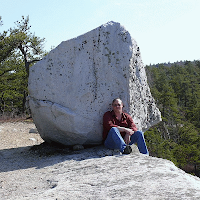The Mid-Hudson Astronomical Association (MHAA) is doing something with SUNY New Paltz over on their campus. If you want something a bit more low key (and with less of a crowd), I'll have a couple of telescopes set up on the SUNY Ulster County Community College campus. We will be observing the Sun with several
filtered telescopes from the start of the transit around 6:00 pm until the Sun disappears from
view as it sets over the Catskills to the west around 8:30 pm. The telescopes will be set up on
the lawn next to the Mcdonald DeWitt library and community members are welcome to come and
observe if they're interested. The observation will only be held if we can see
the Sun (in other words, if it's not too cloudy). Here are driving directions to the Main Campus. For additional information,
contact me.
So, what exactly is a transit of Venus? Well, it turns out that every once in
a while (and I'll explain this in more detail shortly), the planetary orbits of
Venus and Earth align such that we can see Venus passing directly in front of
the Sun. Looking at the Sun with appropriate solar filters will allow us to
watch the passage of the dark circle of the planet across the face of the bright
Sun. Below are a set of images, taken 30 minutes apart, of the last transit of
Venus which occurred on June 8, 2004.
Image © F. Espenak (MrEclipse.com)
I observed the 2004 transit at SUNY Ulster with a number of people but then it was early in the morning as the Sun was rising.
So how often do transits of Venus occur? It turns out that they are very rare. If you missed the transit in 2004, and the upcoming transit on June 5, you will never see one again. The next transit isn't going to occur until December 10, 2117. Here are the dates of some past and future transits (courtesy of NASA):
| Past Transits | Future Transits |
| November 23, 1396 | June 6, 2012 |
| May 26, 1518 | December 11, 2117 |
| May 23, 1526 | December 8, 2125 |
| December 7, 1631 | June 11, 2247 |
| December 4, 1639 | June 9, 2255 |
| June 6, 1761 | December 13, 2360 |
| June 3, 1769 | December 10, 2368 |
| December 9, 1874 | June 12, 2490 |
| December 6, 1882 | June 10, 2498 |
| June 8, 2004 | December 16, 2603 |
Notice anything? They come in pairs (summer and winter) eight years apart separated by longer periods of over a century. There's a definite repeating pattern of transits occurring every 105.5, 8, 122.5, and 8 years. This is no accident - it's due to the period of the Earth's orbit around the Sun (365.25636 days), the period of Venus's orbit around the Sun (224.70069 days), and the angular difference between the plane of Venus's orbit around the Sun and Earth's orbit around the Sun (3.39471°). When everything lines up just right, we can observe a transit.
That's the great thing about physics. Astronomers can predict, for example, a transit of Venus will occur on June 23, 3956 at 21:21 UTC - almost 2,000 years in the future (hopefully, humanity will still be around to observe it!).
Here are the nitty, gritty details of the transit:
Times are given in 24-hour format Universal Time which is 4 hours ahead of Eastern Daylight Time (EDT). Venus will first "touch" the edge of the Sun at 6:09:38 pm EDT, appear entirely within the Sun at 6:27:34 pm EDT, and reach the middle of the transit at 9:29:36 pm EDT. Unfortunately, here at SUNY Ulster, the Sun will set at 8:28 pm EDT (actually a bit earlier since there are the Catskill Mountains to the west where the Sun is setting).
There is a lot of interesting history regarding the scientific study of past transits. For more information on this and the upcoming transit, see the following websites.
* A website dedicated to the transit
* NASA's transit of Venus website
* Transit information from the Exploratorium
* Sky & Telescope article about the transit
By the way, here's where every blogger writes "Don't stare at the Sun with your naked eye!" Not me. I'll just issue my standard statement regarding solar events - If you're stupid enough to go outside and stare slack-jawed at the Sun with your unprotected eyes, go right ahead. Hurts, don't it? That's why more intelligent people don't do that.









































